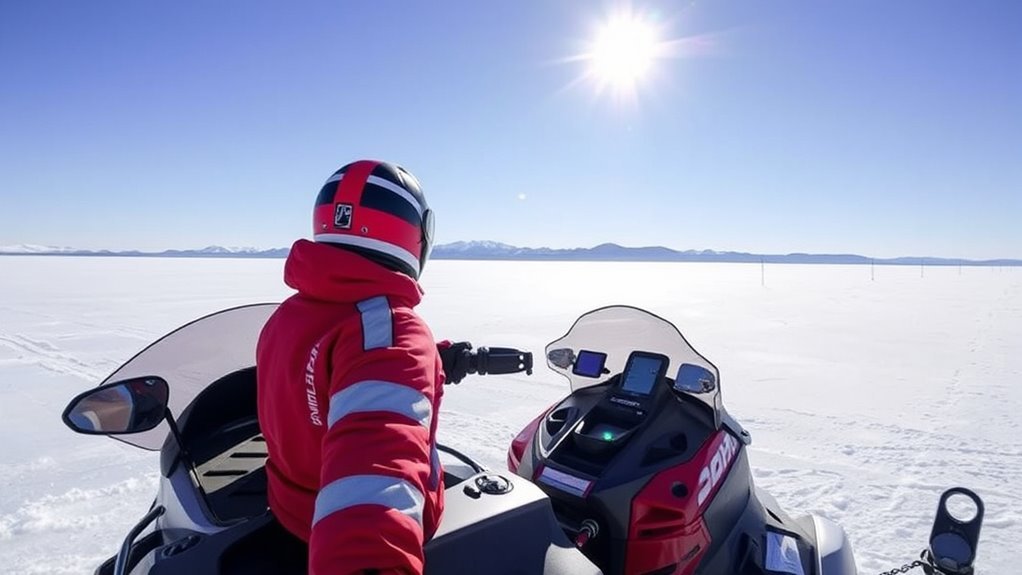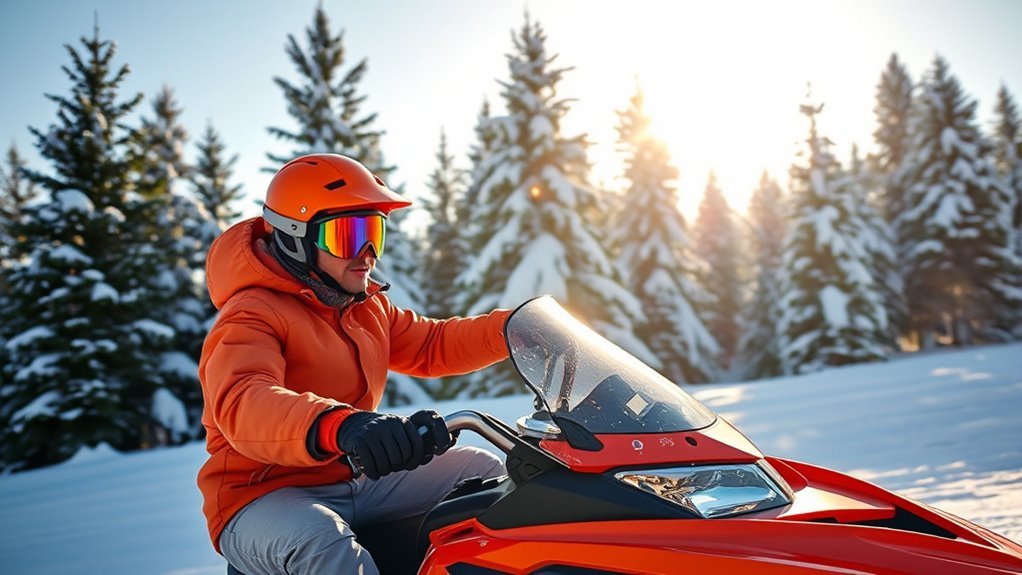Safety should be your top priority when gearing up for a snowmobiling adventure. It’s not just about having fun; it’s about ensuring you get back home safely. You might think you know the basics, but there are essential tips that even seasoned riders often overlook. What could be missing from your checklist that guarantees thrill and security on the trails?
Key Takeaways
- Always ride sober; alcohol impairs judgment and increases the risk of accidents.
- Wear a DOT-approved helmet and dress in layers to stay warm and protected.
- Check weather forecasts and trail conditions before heading out to ensure safety.
- Ride with a buddy and inform someone about your destination and return plans.
- Avoid riding on ice unless necessary; stick to marked trails for safety.
Understanding Weather and Trail Conditions

Staying informed about the weather forecasts and trail conditions before hitting the trails is essential to guaranteeing a safe snowmobiling experience.
Always check for trail closures and maintenance updates, which can greatly affect accessibility and safety.
Planning your trip involves consulting trail maps and gathering local information to understand the terrain and potential hazards along your planned route.
Adverse weather, like heavy snowfall or rain, can lead to poor visibility and slippery surfaces, increasing the risk of snowmobile accidents.
Pay close attention to ice conditions, especially when riding near lakes and rivers. Avoid crossing unless you’re on marked trails that have been checked for safety.
These precautions help guarantee a safer, more enjoyable snowmobiling adventure.
The Dangers of Alcohol While Snowmobiling
When you’re snowmobiling, drinking alcohol can drastically impair your reaction and judgment, making it difficult to respond quickly to obstacles or changes in terrain.
Alcohol also increases your risk of hypothermia by hindering your body’s ability to regulate its temperature, despite the false warmth you might feel.
Staying sober guarantees not just your safety, but also keeps the trails safer for everyone.
Impaired Reaction and Judgment
Despite the thrill snowmobiling offers, mixing it with alcohol can lead to dire consequences. Your impaired reaction time from drinking jeopardizes not only your safety but also the safety of others on the trail.
Here are some essential safety tips to keep in mind:
- Zero Alcohol consumption: Commit to staying sober to guarantee you’re fully alert and focused while operating the snowmobile.
- Snowmobile operation: Understand that alcohol affects vision, balance, and coordination, increasing the risk of accidents.
- Wear appropriate gear: Staying warm and protected helps maintain focus and control, reducing the chances of mishaps.
Increased Hypothermia Risk
While snowmobiling can be an exhilarating winter activity, mixing it with alcohol increases the risk of hypothermia, a danger often underestimated.
Alcohol consumption impairs your ability to make sound decisions and react quickly, essential aspects of snowmobile safety. In Minnesota, the alarming statistic of over 60% of fatal snowmobiling accidents involving alcohol underscores the perils of riding under the influence.
Although alcohol might make you feel warmer, it doesn’t increase body heat; instead, it numbs the sensation of cold, heightening your vulnerability to hypothermia. Cold weather and impaired judgment can prevent you from realizing when you need to seek warmth or add layers of outer clothing.
Embrace responsible riding practices by avoiding alcohol to guarantee safety in the snow.
Essential Riding Safety Practices

When snowmobiling, always ride with a buddy to enhance your safety and guarantee help is readily available in emergencies.
Don’t forget to wear a quality DOT-approved helmet and facemask to protect yourself from head injuries and cold weather.
These essential riding practices can greatly reduce risks and make your snowmobiling experience more enjoyable.
Buddy System Benefits
Riding with a buddy isn’t just more fun; it’s an essential safety practice that can save lives. When you’re snowmobiling, having a riding buddy greatly enhances your safety. It guarantees immediate assistance in case of mechanical failures or accidents, which is critical since most snowmobile accidents happen when riding alone.
A riding buddy provides:
- Immediate help: Quick assistance reduces risks if something goes wrong.
- Effective communication: Use hand signals to maintain awareness and navigate safely.
- Shared experiences: Exchange tips and enjoy the adventure together.
Furthermore, the buddy system strengthens your communication on the trail, making it easier to stay connected and alert.
Always inform a friend or family member about your destination and return plans, further improving your safety.
Protective Gear Essentials
Snowmobiling gear acts as your first line of defense against the elements and potential hazards on the trail. Always wear a quality DOT-approved helmet and facemask to guard against head injuries and harsh weather.
Dressing in layers is essential, starting with a windproof outer layer to keep you warm and dry. A good windproof layer protects you from the biting cold and wind chill. Additionally, ensure your extremities stay warm with insulated gloves and boots to prevent frostbite.
Remember a buoyant snowmobile suit; it’s not just about warmth—it offers flotation if you fall through ice.
Finally, emergency supplies like a first-aid kit and waterproof matches should be carried to prepare for unexpected situations on the trails.
Trail Etiquette and Maintenance Guidelines
Although the thrill of snowmobiling can be exhilarating, trail etiquette and maintenance guidelines must be followed to guarantee everyone’s safety and enjoyment.
Always wear appropriate gear and stay on designated snowmobile trails to avoid unnecessary trail closures and protect natural habitats. Respect private property by obtaining landowner permission before riding to prevent trespassing issues.
To keep everyone safe, come to a complete stop at intersections, looking both ways before proceeding. Respect the posted trail conditions and closures; they maintain safety and preserve the riding experience.
Here are some key points to remember:
- Use only designated snowmobile trails
- Always obtain landowner permission before riding on private property
- Stop completely at intersections to guarantee safety
Ice Riding Precautions and Safety

When venturing onto ice with your snowmobile, it’s crucial to prioritize safety to prevent accidents. Always avoid riding on bodies of water like lakes and rivers unless necessary. These surfaces can hide thin and weak ice, increasing the risk of serious accidents or drowning.
If you must ride on ice, wear a life jacket over your outer clothing to enhance safety if you fall through. Stick to marked trails verified for safety to reduce risks. Remember, ice with moving water underneath is typically weaker and more prone to breaking.
Familiarize yourself with local ice conditions, evaluating thickness and stability before crossing. Your vigilance guarantees a safer snowmobiling experience on potentially dangerous ice.
Importance of Pre-Ride Inspections
While riding on ice demands cautious attention, it is equally essential to ensure your snowmobile is in top condition before hitting the trails.
Pre-ride inspections are vital for riding safety, helping to prevent mechanical failures that could lead to accidents. Don’t overlook these key checks:
- Throttle, brakes, and lights: Verify they function properly to minimize safety hazards.
- Fuel levels: Confirm you’ve got enough gas to avoid unexpected stops.
- Regular maintenance: Follow your owner’s manual for pre-operation checks to enhance performance and longevity.
These steps help identify issues early, avoiding equipment malfunctions that can ruin your day.
Conclusion
When you’re snowmobiling, always prioritize safety. Check weather and trail conditions before you head out, and let someone know your plans. Stay on designated trails and respect all signs. Never drink and ride; it’s just not worth the risk. Wear a DOT-approved helmet and dress in layers to keep warm. Riding with a buddy and carrying emergency supplies can make all the difference. Finally, always conduct a pre-ride inspection to guarantee your snowmobile is in shape.
FAQs
1. How to Stay Safe While Snowmobiling?
You should always wear a certified helmet and dress warmly. Don’t drink and ride—it’s risky. Check your snowmobile before heading out. Stick to trails, respect property, and adjust your speed for safety and environmental care.
2. What Not to Do on a Snowmobile?
Don’t ride under the influence, speed excessively, or go alone. Avoid leaving designated trails or riding on private property without permission. Steer clear of lakes and rivers unless necessary, and always stick to marked trails.
3. What Is the Safest Way to Stop a Snowmobile on Ice?
Gradually ease off the throttle and apply the brakes smoothly to avoid skidding. Lean back slightly to maintain control. Always stop completely before reaching the ice’s edge and stay aware of your surroundings for hidden hazards.
4. What Are the Risks of Snowmobiling?
When you’re snowmobiling, you’re facing several risks like alcohol impairment, excessive speed, and thin ice. Weather conditions can also endanger you. Riding alone increases your risk, so always have a buddy to guarantee safety.

